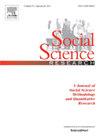社会孤立的流行病?2004-2018年老年人社会联系的年龄和队列趋势
IF 3.5
2区 社会学
Q1 SOCIOLOGY
引用次数: 0
摘要
尽管老年人越来越担心社会孤立,但社会变化(如非亲属关系、非宗教社会参与和数字媒体使用的增加)在塑造年轻群体的社会联系方面的潜在作用仍未得到充分研究。这项研究超越了传统的核心亲属关系、宗教社会参与和面对面接触的衡量标准,更好地反映了新兴的社会变化。本文将分层增长曲线模型应用于健康与退休研究(HRS, 2004-2018, N = 42,959个观察值),研究了个体年龄社会联系轨迹的队列变化和队列内社会差异的变化。与通常的假设相反,研究结果表明,尽管社会联系从抑郁症晚期儿童到战争婴儿和早期婴儿潮一代下降,但在最近的婴儿潮中后期,这种联系明显停滞。从生命历程的角度来看,随着年龄的增长,婴儿潮中期和后期出生的人甚至表现出明显较慢的下降速度,而他们的前辈则表现出加速下降的轨迹。此外,在每个队列中,女性和西班牙裔老年人始终表现出比男性和白人同行更高的社会联系,这种差异在婴儿潮中后期也变得更加明显。进一步的分析表明,这些趋势可以部分解释为婴儿潮一代在社会经济地位、身体健康和性别/种族/民族平等方面的改善。然而,强调远距离关系、非宗教社会活动和数字通信的重要性的社会变化可能在弥补传统联系的下降方面发挥更重要的作用。这些发现反映了当代美国家庭和社会化实践中更广泛的文化转变。本文章由计算机程序翻译,如有差异,请以英文原文为准。
An epidemic of social isolation? Age and cohort trends of social connectedness among older adults, 2004–2018
Despite growing concerns of social isolation among older adults, the potential role of societal changes, such as the rise in non-kin relations, non-religious social participation, and digital media use, remains understudied in shaping social connectedness among younger cohorts. This study moves beyond traditional measures of core kinships, religious social participation, and in-person contact to better reflect emerging societal changes. Applying Hierarchical Growth Curve Modeling to the Health and Retirement Study (HRS, 2004–2018, N = 42,959 observations), this paper examines cohort variations in individual age trajectories of social connectedness and the changing intracohort social disparities. Contrary to common assumptions, results suggest that although social connectedness decreases from Late Children of Depression to War Babies and Early Baby Boomers, it notably stalls among more recent Mid and Late Baby Boomers. From a life course perspective, Mid and Late Baby Boomers even exhibit significantly slower decline rates as they age, while their predecessors demonstrate accelerated declining trajectories. Moreover, women and Hispanic older adults consistently demonstrate higher social connectedness than their male and White counterparts within each cohort, with these differences also becoming more pronounced among Mid and Late Boomers. Further analyses indicate that these trends can be partially explained by baby boomers’ improvements in socioeconomic status, physical health, and gender/racial/ethnic equality. However, societal changes that emphasize the significance of distant relations, non-religious social activities, and digital communication may play a more important role in compensating for the decline of traditional connections. These findings reflect broader cultural transitions in family and socialization practices in contemporary America.
求助全文
通过发布文献求助,成功后即可免费获取论文全文。
去求助
来源期刊

Social Science Research
SOCIOLOGY-
CiteScore
4.30
自引率
4.00%
发文量
0
审稿时长
65 days
期刊介绍:
Social Science Research publishes papers devoted to quantitative social science research and methodology. The journal features articles that illustrate the use of quantitative methods in the empirical solution of substantive problems, and emphasizes those concerned with issues or methods that cut across traditional disciplinary lines. Special attention is given to methods that have been used by only one particular social science discipline, but that may have application to a broader range of areas.
 求助内容:
求助内容: 应助结果提醒方式:
应助结果提醒方式:


